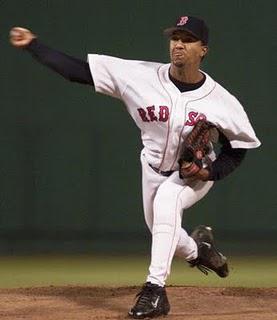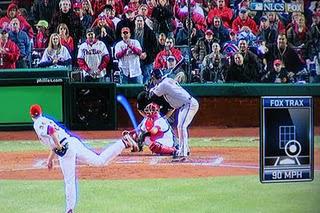When you listen to major league announcers, especially the former major leaguers, you'll hear them say some great stuff. I always recommend that my players really pay attention to the announcers when they watch games because they can learn a lot about the game just by listening. The problem that arises, though, is that announcers don't always have enough time to get into further detail or expand upon/explain some of the comments they make. Here is an example.The other night I'm watching a Phillies game and one of the announcers says that a particular pitcher "throws too many strikes." Now, the average fan and/or player constantly hears about the importance of throwing strikes when it comes to pitching. So how in the world can an announcer say that a pitcher throws too many strikes? Is it possible?The answer is YES and there are two reasons why.
Although not loved by hitters, Pedro Martinez knew
the importance of being "effectively wild."
1. There is something to be said for being "effectively wild." If you have ever seen the film Bull Durham you have seen how being "effectively wild" can help a pitcher. In the film, remember when pitcher Nuke LaLoosh was cruising along in the game and the catcher (Crash Davis) came out and told him to throw the next pitch at the mascot - the Bull? Do you remember the reaction of the batter when he did it? After he saw the pitch hit the Bull, the batter wasn't too quick to dig in at the plate for fear that the next one might be at his head as well. He pulled everything out on the next swing and missed it by a foot for strike three. I don't want pitchers throwing at batters (or mascots) but the point is, a little fear on the part of the batter goes a long way in helping a pitcher. If just about every pitch is in the strike zone, particularly on the outer half of the plate, a batter will feel safe and not worry about being hit by the ball. As a result, his swings are probably going to be very aggressive. That's not good news for the pitcher. If a pitch comes inside every now and then and moves the batter off the plate, he may not be as aggressive in the future because he will be conscious of the fact that the next pitch may be up and in again.Many young pitchers have a hard time distinguishing between throwing inside and hitting batters. There is a huge difference between the two. What I am talking about is throwing inside. For strikes on the inner half of the plate as well as missing inside a little to move the batter back. No great pitcher was ever afraid to throw inside to put a little fear in the batter's mind, even if the pitch was not a strike. Coming out of Halladay's hand it looks like
a strike but ends up below.
2. Living near Philadelphia, I have the pleasure of watching Roy Halladay pitch every five days. And what a pleasure it is! A young pitcher who does not get the chance to see Halladay throw is missing a chance to see a clinic on how to be a good pitcher. I could go on and on about what makes Roy Halladay so special but we'll concentrate on the "throwing too many strikes" angle. Like most great pitchers, Halladay is effective, in part, because many of his pitches leave his hand and give every impression that they will be in the strike zone. When the batter starts to swing, however, late movement often takes the pitch out of the strike zone making it very difficult to hit. In essence, he gets a lot of hitters to chase pitches out of the strike zone. When a pitcher can do this, his odds of getting the batter out increase dramatically. Of course, Halladay often gets ahead in the count by throwing the first few pitches over the plate but after he does, he then gets them out by going out of the strike zone with his movement on the pitch. Pitchers who start their pitches in the strike zone and finish there as well are giving the batter a better chance to hit the ball.Having the accuracy to throw inside without hitting a batter along with late movement which takes the ball out of the strike zone at the last minute does not come easy. It takes a lot of talent and hard work to accomplish both. If a pitcher cannot achieve one or both of these, he may, in fact, be throwing too many strikes.



